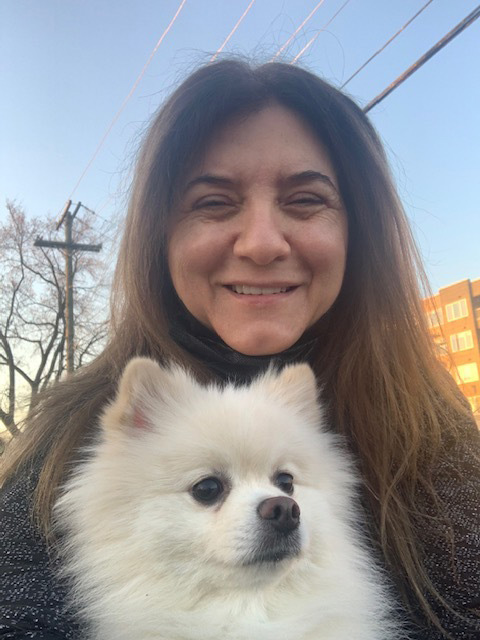
Inaya Hajj Hussein, Ph.D., is course director for the Renal and Urinary Organs System Course at Oakland University William Beaumont School of Medicine and also teaches Anatomical Sciences to M1 and M2 students. She is a member of the Admissions Committee and of the M1/M2 Curriculum Subcommittee. She joined OUWB in 2012.
1. What led you to a career in histology?
During the preparation of my Ph.D. thesis between the department of Anatomy and Cell Biology at the American University and the University of Louis Pasteur in Strasbourg, France, with my background in immunology and microbiology, I started working on inflammatory bowel diseases in an animal model studying its pathogenesis and the place of microbiota in the process. My advisor was a well-known anatomical sciences professor in charge of the gross anatomy, histology, and embryology. I spent a lot of time studying histology and histopathological alterations in the gastrointestinal tract as well as other systems and organs using various stains, immunohistochemical, and advanced microscopic techniques. I was fascinated by the wealth of knowledge one can acquire at tissue and cellular levels and the detailed manifestations of various diseases and the extent to which they can help in the diagnosis and management. Soon, I started helping my advisor with teaching medical and paramedical students and that brought me a lot of self-satisfaction; I decided to become a histology educator and researcher, and I never regret it.
2. As a histologist, how has COVID-19 and its vaccine provided you with new material for teaching our medical students?
With my background in immunology, microbiology, and histology, with some histopathology, I was able to understand COVID-19 and its health implications as well as the need to allow our students more understanding about COVID 19 in their curriculum. Along this line, I was able to recommend to the respiratory course director to include a lecture about COVID-19 in collaboration with my colleagues (Drs. Baxa and Cortes) in the respiratory organ system course.
Related: Take 5 with OUWB Foundational Medical Studies Educator of the Year Varna Taranikanti Take 5 with Stefanie Attardi, Ph.D., assistant professor of anatomy at OUWB |
I also entertained the idea of developing a short course comparing COVID-19 to other viruses, thus showing its uniqueness in various aspects and at various technical levels including electron microscopy. I already published some articles on HPV viruses as well as a very well-cited review article on vaccines through the centuries. I demonstrated in research that vaccines constitute one of the greatest success stories within the health sector. Prior to the pandemic, I highlighted the major historical cornerstones in the development and progress of various types of vaccines since the beginning and through the ages in a review titled: “Vaccines Through the Centuries: Major Cornerstones of Global Health.” In the conclusion section, I emphasized that clinicians and public health workers need to interact on a regular basis with veterinarians and public health experts. I gave examples of the necessity of such collaboration in the emergence of SARS-CoV and MERS-CoV, and how coronaviruses could spillover from animals into humans, causing lethal diseases. During the COVID-19 pandemic, I wrote a review about SARS-CoV-2 a multidisciplinary review of the current literature involving the SARS-CoV-2 virus. I reviewed the origin of the virus, the course of the disease, the therapeutic investigations, and the global response. Specifically, we discussed pathogenesis and described the histopathology.
3. What is your favorite part about being a faculty member at OUWB?
My favorite part of being a faculty member at OUWB has been the freedom to explore teaching new approaches. I enjoy having the opportunity to create new innovative ways in the teaching of histology such as integration with pathology, immunology in other disciplines, and virtual teaching.
After my move to OUWB, I gained a lot of interest in medical education. I like the variety of faculty development programs, online webinars, and other resources and opportunities the school provides to faculty. I have attended many workshops on teaching and learning which I consider very relevant to my mission and duties as an educator to appropriately design, review, and evaluate the curriculum, which are dynamic processes in learning.
I love teaching at OUWB. I love my students. They remind me of my children, and also the idea that I get to do something that might have a real impact; even a small one, is huge to me. Medical education is not just a program for building knowledge and skills in its recipients... it is also an experience that creates attitudes and expectations (Abraham Flexner).
I also like that (OUWB) is committed to building an environment where all students and faculty are valued and feel a sense of belonging, and to create a diverse and inclusive community and curriculum.
4. What you are looking forward to doing when we are able to return full time to campus?
What I miss most is interacting with my students and my colleagues. The first thing I will do is invite available faculty members for a cup of coffee at the O.C.
5. Can you tell us one thing that people at OUWB probably don’t know about you?
I am a first-generation college graduate and a self-made woman who loves liberal arts and who works hard to empower women in general. I am a single mother who raised four children: three physicians (1 ER, 2 Geriatrics, and all Beaumont graduates!) and one architect.

